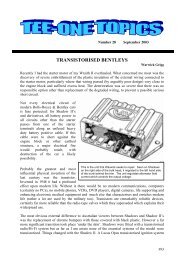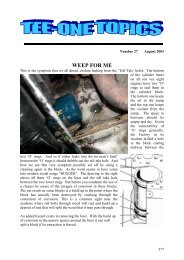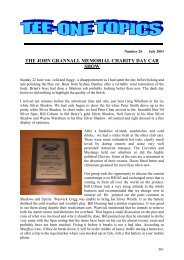Issue21 Feb03 - Rolls Royce & Bentley Owners Club - South Africa
Issue21 Feb03 - Rolls Royce & Bentley Owners Club - South Africa
Issue21 Feb03 - Rolls Royce & Bentley Owners Club - South Africa
You also want an ePaper? Increase the reach of your titles
YUMPU automatically turns print PDFs into web optimized ePapers that Google loves.
warning lights come on. In the worst case the light/s will come on while you are driving and<br />
applying the brakes. At this stage the nitrogen will be completely exhausted and the only<br />
pressure the brakes can receive is that direct<br />
from the pumps. If the engine should stall you<br />
will have no way of stopping!<br />
With no nitrogen present the pumps forcing<br />
oil into the accumulators push the diaphragm<br />
hard into the charging point hole which has<br />
sharp edges. The result is a punctured<br />
diaphragm. At this stage there is only one<br />
recourse, remove the units and completely<br />
overhaul them.<br />
The left hand accumulator on the Shadow II<br />
Recharging<br />
If the control valves and the rest of the system<br />
appear to be functioning correctly and the<br />
spheres still retain some nitrogen pressure it<br />
may be possible to recharge them. It is<br />
emphasised that this is a suggested remedy<br />
and is offered without any guarantee. It<br />
requires special equipment that needs to be<br />
bought or borrowed. As far as is known no<br />
dealer or repair shop uses this technique and it<br />
is certainly not recommended by the Factory.<br />
The procedure however is followed by many<br />
Citröen enthusiasts on their cars. Basically the procedure involves raising the car to a working<br />
height, completely exhausting the accumulators, removing the caps on the re-charging points,<br />
removing the plastic sealing balls, screwing on the supply hose and using a high pressure gas<br />
regulator and cylinder of nitrogen to gradually admit nitrogen to the accumulator. When the<br />
1000 psi registers, the gas is turned off the supply pipe unscrewed, a new plastic sealing ball<br />
inserted and the cap replaced. The last actions need to be done swiftly as the non return valve<br />
retaining the gas in the sphere is a steel ball in a steel seat and the seal is not very effective<br />
hence the plastic sealing ball.<br />
All this is by way of an interest event. Please do not charge into your garage man and ask him<br />
to re-charge your accumulators as he will politely decline.<br />
<br />
MONEY (Or lack thereof)<br />
The 18 th of January this year at our self help group saw a mob of determined people insist on my<br />
recovering some of my expenses in producing these pages. For those that came in late, the Tee<br />
One Topics were initally thrown together to keep a record of lessons learnt during the self help<br />
sessions of our little group. The ‘parent body’ then made it quite clear that our efforts were not<br />
wanted and that there was little or no interest in matters technical in the <strong>Club</strong>. I was determined<br />
289






